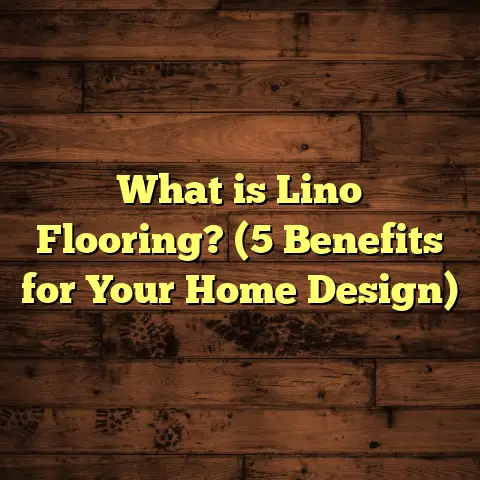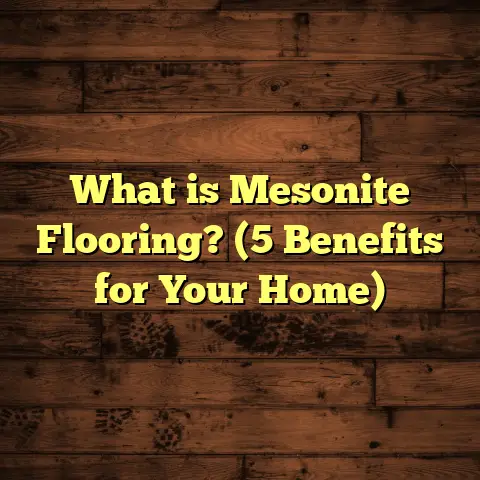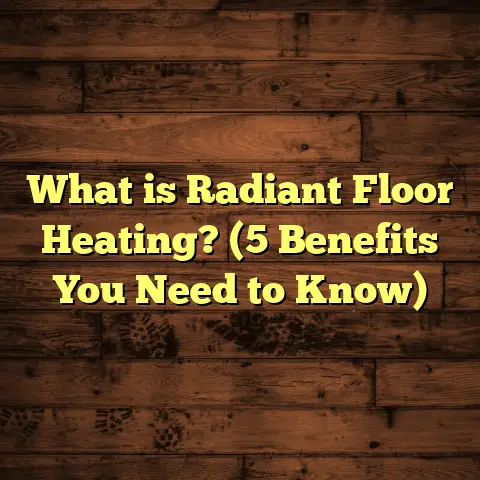What is Vinyl Plank Flooring? (5 Key Benefits Explained!)
When I think about family life at home, I can’t help but remember all the little moments that make a house a place we truly love. From the sound of children laughing as they run barefoot across the floor to quiet evenings spent relaxing after a busy day, the floors beneath our feet play a surprisingly big role in how comfortable and practical a home feels.
I’ve been fortunate to work as a flooring contractor for years and have installed almost every kind of flooring you can imagine. Through all those projects and my own home renovations, one type of flooring has consistently stood out as a perfect fit for families: vinyl plank flooring. It’s become a go-to solution for families balancing style, durability, and budget.
If you’re wondering what vinyl plank flooring is and why so many people—including myself—are choosing it for their homes, I’d like to walk you through everything I’ve learned. I’ll share practical advice, personal stories, and real-world data to help you decide if vinyl plank flooring might be right for your family.
What is Vinyl Plank Flooring?
Let’s start with the basics: what exactly is vinyl plank flooring? At its core, vinyl plank flooring is a synthetic flooring product designed to look like natural wood. Instead of actual wood layers like in hardwood floors, vinyl planks are made from multiple layers of vinyl material, each serving a specific function.
The top layer is a wear layer—a tough protective coating that resists scratches, stains, and dents. Beneath that is a high-resolution photographic layer that realistically mimics wood grains, knots, and textures. This is why vinyl planks can look so much like real hardwood.
Below the design layer sits the core layer, which provides stability and often waterproof qualities. Some cores are made with stone plastic composite (SPC) or wood plastic composite (WPC), offering extra strength and comfort underfoot. The bottom backing layer adds support and sometimes sound insulation.
The planks themselves vary in size but typically measure between 6-9 inches wide and 36-48 inches long. They come in a variety of thicknesses from around 4mm up to 8mm or more.
One of the reasons families love vinyl plank flooring is its versatility—it can be installed over concrete slabs, existing tile or wood floors, or plywood subfloors. Many products feature click-lock mechanisms that allow for floating floor installation without glue or nails.
How Is Vinyl Plank Flooring Different From Other Floors?
You might ask: how does vinyl plank flooring compare to laminate or hardwood? The biggest differences lie in durability, moisture resistance, cost, and maintenance.
- Hardwood Flooring: Made from real wood; beautiful but expensive and prone to scratches and water damage.
- Laminate Flooring: Uses wood fiber core with a photographic surface; less water-resistant than vinyl but cheaper than hardwood.
- Vinyl Plank Flooring: Fully synthetic layers; waterproof core; excellent scratch resistance; affordable with realistic looks.
From my experience, vinyl plank floors combine many of hardwood’s aesthetic benefits with the practicality laminate offers—but with superior moisture resistance.
1. Durability That Handles Family Life
If you have kids or pets—or both—you know how tough it is to keep floors looking good. Scratches from pet claws, dents from dropped toys or furniture, spills… life happens fast around family homes.
Vinyl plank flooring stands up remarkably well to these daily challenges. The wear layer on top protects against scratches better than many hardwoods or laminates I’ve worked with. In fact, some high-end vinyl planks feature wear layers measuring up to 30 mils (thousandths of an inch), which means they can handle heavy commercial traffic too.
I remember installing vinyl plank flooring in a client’s home where two teenagers shared their space with a large dog breed. After nearly two years with constant activity—pets running in and out with muddy paws, furniture being rearranged—the floor looked almost new. No deep scratches or dents showed up.
Another key advantage is water resistance. Vinyl plank floors with waterproof cores won’t warp or swell when exposed to moisture—a common worry in family homes. In my own household, spills happen regularly—from juice boxes overturned by toddlers to wet boots tracked in from outside. Our vinyl plank floors handled all these without any issues.
Data Point on Durability
According to Resilient Floor Covering Institute (RFCI) studies, properly installed vinyl plank flooring can last between 15-20 years even in high-traffic family rooms. Many manufacturers back their products with warranties spanning 15 years or more for residential use.
Advice from my experience: If your home sees heavy foot traffic or pets, look for products with at least a 20-mil wear layer and a waterproof core like SPC or WPC. This combination offers resilience without sacrificing comfort.
2. Affordable Without Sacrificing Style
I’ve seen homeowners hesitate about updating their floors because they assume quality means sky-high prices. Vinyl plank flooring challenges that assumption completely.
When I first started recommending vinyl plank flooring years ago, the designs were simple and often felt “fake.” But today’s products look stunning—authentic wood grains, hand-scraped textures, even distressed barnwood styles are available.
Prices vary by brand and quality but here’s what I typically see:
| Flooring Type | Material Cost (per sq.ft.) | Installation Cost (per sq.ft.) | Total Cost (per sq.ft.) |
|---|---|---|---|
| Vinyl Plank Flooring | $2 – $7 | $1.50 – $3 | $3.50 – $10 |
| Hardwood Flooring | $5 – $12 | $4 – $8 | $9 – $20 |
| Laminate Flooring | $1 – $4 | $1 – $3 | $2 – $7 |
These numbers show how vinyl plank flooring gives you style close to hardwood at about half or less the total installed cost.
Personal Story on Budget
A couple I worked with wanted the look of oak hardwood floors for their growing family’s living room but had a tight budget due to other renovations. We chose a mid-grade vinyl plank option with realistic grain patterns and warm tones. The result was breathtaking and within budget. They told me later they were thrilled with how “high-end” their floors looked despite spending much less than expected.
If cost is a concern—and it often is for families managing multiple expenses—vinyl plank flooring offers an excellent balance of beauty and affordability.
Pro Tip: Don’t just pick the cheapest option though! Look for brands with strong warranties and positive reviews on durability to avoid early replacement costs.
3. Easy Installation Saves Time and Money
From my years on site with flooring crews and helping friends with DIY projects, I can say vinyl plank flooring is one of the easiest floors to install well.
Most modern vinyl planks use click-lock technology that lets you snap boards together without glue or nails. This floating floor method means no messy adhesives or long drying times.
In one memorable weekend project with friends who had never installed floors before, we transformed a basement by laying down vinyl planks in just two days. The instructions were straightforward, cuts were easy using basic tools, and cleanup was minimal.
For professional contractors like myself, installation can be even quicker because there are fewer complications compared to hardwood requiring acclimation or glue-down tile requiring curing time.
Installation Tips Based on Experience
- Always check your subfloor’s condition before starting—vinyl planks need a flat surface free of debris.
- Allow planks to acclimate in the room for 48 hours before installation for best results.
- Use spacers along walls to leave room for expansion.
- If doing DIY, rent or borrow good cutting tools to make clean edges.
- Consider professional installation if your subfloor is uneven or if you want a flawless finish.
4. Low Maintenance for Busy Families
One thing almost every homeowner appreciates is easy cleaning and upkeep. Vinyl plank flooring excels here too.
Unlike hardwood floors that may need special cleaners or refinishing over time, vinyl floors only require routine sweeping and mopping with mild soap solutions.
In my own home, I’ve found that routine vacuuming or sweeping combined with occasional damp mopping keeps floors looking fresh even after messy playdates or holiday dinners.
With pets around, accidents happen but quick cleanup prevents stains or odors from setting in. Vinyl’s waterproof surface means liquid won’t seep into seams or cause damage underneath.
Maintenance Advice
- Use pH-neutral cleaners designed for vinyl flooring to preserve the wear layer.
- Avoid abrasive scrubbers which can dull the finish.
- Place mats at entryways to reduce dirt tracked in.
- Use furniture pads to prevent scratches from moving chairs or tables.
- Clean spills promptly to prevent sticky residues.
5. Versatility in Design and Application
Another reason vinyl plank flooring has become popular with families is its flexibility across rooms and styles.
Because it resists moisture so well, many homeowners install it not only in living rooms but also kitchens, bathrooms, laundry rooms—even basements where humidity can be an issue.
I recently helped a client convert an unfinished basement into a cozy rec room using waterproof SPC vinyl planks. The floor stayed dry despite occasional minor flooding during heavy rains—a testament to how well vinyl copes in challenging environments.
Design-wise, manufacturers offer everything from ultra-modern smooth looks to rustic distressed woods that fit farmhouse aesthetics perfectly.
In one project blending open concept living space with kitchen and dining areas, we used different finishes of the same vinyl plank brand for subtle zoning effects while maintaining continuity.
For families wanting eco-friendly options, some brands provide products made partially from recycled materials or certified low VOC emissions—great for healthier indoor air quality where kids play most.
Personal Insights & Case Study: My Family’s Vinyl Plank Journey
Let me share a bit more about my own experience since I believe firsthand stories resonate best when evaluating flooring choices.
A few years ago, my family decided our basement carpet was no longer cutting it—it trapped dirt easily and looked worn after energetic toddler play sessions and occasional spills. We wanted something durable yet inviting for movie nights and crafts.
After researching many options including engineered hardwood and laminate, we landed on mid-range SPC vinyl plank flooring with a 12-mil wear layer and waterproof core.
Installation took us two days using a click-lock system—much faster than expected—and no major tools were needed beyond a saw and spacers.
Since then:
- Spills wipe up effortlessly without staining.
- Pets’ nails haven’t scratched the surface.
- The floor hasn’t warped despite occasional water spills.
- Cleaning takes just 20 minutes weekly despite heavy use.
- Our basement feels warmer than when carpeted because vinyl doesn’t trap dust like carpet does.
This personal success affirmed my professional recommendation of vinyl plank flooring for busy families seeking style plus practicality.
More Data That Might Help You
I’ve gathered some more stats from industry sources that highlight why families tend toward vinyl plank flooring:
- Growth: Vinyl plank sales have increased over 15% annually over the past five years in North America alone.
- Preference: A Houzz survey found over 70% of families prioritize waterproof floors when renovating kitchens or bathrooms.
- Costs: Flooring installation firms report average labor costs for vinyl planks are 40-60% cheaper than hardwood installations.
- Durability: The Resilient Floor Covering Institute notes average lifespan is 15-20 years under normal residential use.
- Maintenance: Average weekly cleaning time for vinyl is less than 30 minutes versus over an hour for hardwood maintenance routines.
Common Questions I Hear From Families About Vinyl Plank Flooring
Q: Will vinyl planks fade if exposed to sunlight?
A: Most quality vinyl planks have UV inhibitors built into their wear layers to resist fading. However, prolonged direct sunlight can eventually cause some color changes. Using curtains or area rugs helps protect your floor if sunlight exposure is heavy.
Q: Can I install vinyl planks over radiant heating?
A: Yes! Many vinyl plank products are compatible with radiant heat systems but check manufacturer guidelines for maximum temperature limits before proceeding.
Q: How do vinyl planks feel underfoot compared to hardwood?
A: Vinyl tends to feel softer and warmer underfoot due to its layered construction—especially if it has an attached underlayment. Some people prefer this comfort over the hardness of real wood.
Q: Are there environmentally friendly options?
A: Some brands offer eco-conscious lines made partially from recycled content or certified low-VOC adhesives which reduce indoor air pollution—a great choice for homes with small children or allergies.
Wrapping Up: Should You Choose Vinyl Plank Flooring?
From where I stand as both a contractor and homeowner who’s lived with vinyl plank floors daily—yes! It offers an unbeatable combination of durability, style, affordability, ease of care, and versatility that fits modern family life perfectly.
If you want floors that can handle spills and scratches without worry; save money while looking great; install quickly; clean easily; and adapt across rooms—vinyl plank flooring checks all those boxes based on years of real-world experience.
Before deciding though:
- Measure your space carefully.
- Review product specifications paying attention to wear layers and cores.
- Test samples in your home’s lighting.
- Consider professional installation if you want flawless results quickly.
- Factor ongoing maintenance into your plans (it’s minimal but necessary).
Have questions about specific products? Need help planning your project? I’m here if you want guidance tailored to your home’s needs—just ask!
Thanks for spending time learning about vinyl plank flooring with me today! I hope this detailed look helps you make confident choices that support your family’s comfort now and for years ahead.





